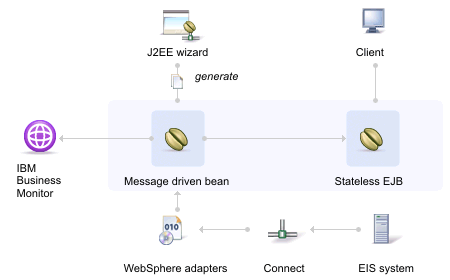IBM Business Monitor, V8.0.1 > Scenarios
Scenario: Monitoring events from an SAP enterprise information system (EIS) without mediation
With IBM Business Monitor, you can monitor events from many different sources and bring them together to obtain a more complete picture of the business. To monitor events sent from an SAP enterprise information system (EIS), in addition to the other events you are monitoring, you can use Rational Application Developer and WebSphere Adapters to send events to the WebSphere Application Server Common Event Infrastructure (CEI), where they are accessible to IBM Business Monitor.
Alternatively, you can use adapters to send events from an EIS to WebSphere Enterprise Service Bus. For more information about this alternative, see the "Business activity monitoring through IBM adapters" scenario.
The following diagram shows the architecture that will be used in this scenario.

Using Rational Application Developer with the WebSphere SAP adapter, which is installed with Rational Application Developer if you select the Java™ 2 connector (J2C) component, you can use the J2C bean wizard to generate the required artifacts. These artifacts include the message-driven J2C bean, as well as the interface, Java data bindings, interceptor class, helper class, and the event schemas that are required for creating a monitor model. You can then deploy the resulting adapter application inbound event monitoring application containing the message-driven bean (the adapter application) to a server, either an IBM Business Monitor server or a remote server. The message-driven bean invokes the stateless session bean that makes the events accessible to the client. More importantly for this scenario, it also listens for events coming in from the EIS and publishes the events to CEI, where they are accessible to IBM Business Monitor.
WebSphere Adapters provide a standard interface to the applications and data on the EIS, so that client applications do not have to understand the implementation of the application or the data structures (lower-level details) on the EIS. During inbound processing, the adapter listens for events that are produced by the EIS (for example, a customer record is updated).
The adapters comply with the Java Connector Architecture (JCA), which standardizes how application components, application servers, and enterprise information systems interact with each other. The adapters make it possible for JCA-compliant application servers, such as WebSphere Application Server, to connect to and interact with the EIS. Client applications running on the JCA-compliant server can then communicate with the EIS in a standard way, using business objects that are represented using Java data bindings.
Suppose a company uses EIS software to coordinate some of its business operations. The company wants to use IBM Business Monitor, which can coordinate events coming from different sources and place the EIS information in the context of the whole enterprise. The EIS includes a business function that returns a list of customers in response to a range of customer IDs. A client application might be able to use this function as part of an overall business application.
For example, the promotions department within the company sends advertising material to customers, and, as part of that process, the promotions department needs to first obtain a list of customers. Using WebSphere Adapters, the promotions department can automatically generate an interface to the EIS function to hide the lower-level details of the function. The client application interacts with the tools-generated adapter application that contains the J2C bean instead of with the EIS function. The adapter application provides an interface that exposes the EIS function to the client application. The data is exposed as business objects represented using Java data bindings, which are also generated by J2C tools.
Using the J2C wizard in Rational Application Developer, you generate and deploy the J2C bean that will transform the business objects into events that IBM Business Monitor can access. The adapter application containing the message-driven J2C bean will listen for events coming in from the EIS system and publish the events to CEI.
Using the IBM Business Monitor development toolkit, you create a monitor model. Based on the event schemas that were generated by the J2C bean wizard, you define inbound events that correspond to the events from the EIS that you want to monitor, and add metrics and KPIs to capture business information from the events. IBM Business Monitor makes the information available from a browser, a mobile device, or your desktop.
- Preparing for monitoring events from the EIS
Before you can monitor events from the enterprise information system (EIS), install the testing and monitoring environments, generate the Java 2 connector (J2C) bean that will transform business objects into events for monitoring, and deploy the adapter application containing the J2C bean. - Create the monitor model
Using the Business Monitor development toolkit, create the monitor model to monitor the events from the EIS. - Testing the monitor model in the toolkit
After you have used the Business Monitor development toolkit to create the monitor model, test the model before deploying the monitor model application to a production server. - Monitoring the events from the EIS with IBM Business Monitor server
After you have finished creating and testing your monitor model, you can generate the monitor model application, deploy the application, and start monitoring events from the SAP EIS. - Troubleshooting the EIS scenario
If you have trouble with the application after it is installed in a production environment, you can turn on tracing to see why an event was not received. You can also install the Common Base Event browser to view the events.
Related tasks:
Scenario: Business activity monitoring through IBM adapters